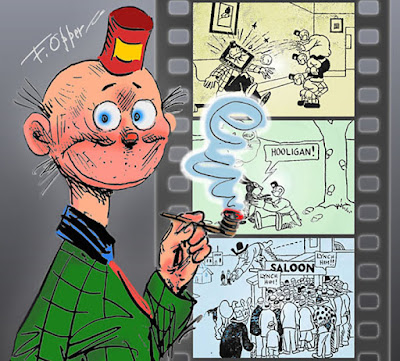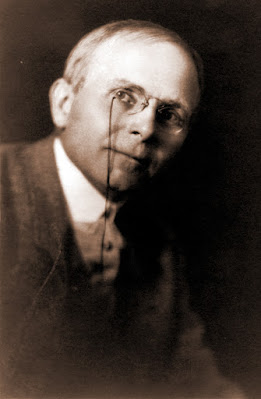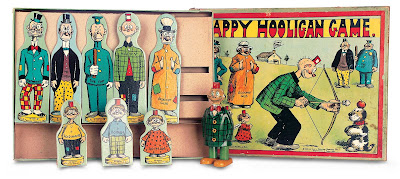The Happy Hooligan comics were an immensely popular comic series in the first three decades of the Twentieth century. Created by cartoonist Frederick Burr Opper, it debuted in 1900. Opper was a political cartoonist and illustrator who created the strip while working at the Hearst Newspaper chain. It gained international popularity running until 1932 when Opper’s eyesight began to fail, leading to his retirement.
The Happy Hooligan comic strip followed the exploits of the Hooligan brothers, three poor, affable hobos with an aversion to work whose adventures made up the premise for the comic strip. The family consisted of the three brothers, Happy Hooligan, Gloomy Gus and Montmorency. Rounding out the cast of characters were Happy’s girlfriend Suzanne, Happy’s dog Flip, the brother's three wisecracking nephews, and an ever present policeman.
Frederick Burr Opper
Its great popularity led to a marketing boom for Hearst Newspapers with the creation of three live action short films and an estimated 50 cartoon features. There were also theatrical productions, books, dolls, toys, games, ceramics and associated ephemera.
Happy Hooligan comic strip (1914)
Happy Hooligan’s nephews with Happy, Gloomy Gus and the always present policeman.
Happy Hooligan game
Happy Hooligan Steiff doll
Happy Hooligan wind-up toy
German Happy Hooligan Christmas ornament
Happy Hooligan roly-poly toy
Ad for Happy Hooligan cartoon movie
Happy Hooligan sheet music
Happy Hooligan theatrical poster
Happy Hooligan Valentine postcard
Happy Hooligan holiday postcard
Happy Hooligan, the character, was resurrected briefly in the early 1960s as a recurring visitor in Sam’s Strip, a comic strip that featured characters from other comic series’.
Happy Hooligan in Sam's Strip
All three Hooligan brothers made their way into majolica figures made by Continental majolica potteries with an occasional appearance by Flip, the dog.
Continental Happy Hooligan majolica humidor
Continental Happy Hooligan majolica bottle
Happy Hooligan majolica smoking stand
Continental Happy Hooligan majolica vase
Continental Happy Hooligan majolica candlestick
Continental majolica Happy Hooligan vase
Continental Happy Hooligan majolica planter
Continental Happy Hooligan majolica bottle
Majolica Gloomy Gus bottle
Continental Gloomy Gus majolica tray
Continental Gloomy Gus majolica match striker
Continental Gloomy Gus majolica smoking stand
Continental Montmorency majolica bud vase
Continental majolica Montmorency dish
Majolica Montmorency bottle
Majolica Montorency smoker's stand
Montmorenccy majolica bottle
Continental Montmorecy majolica candlestick
Continental majolica Montmorecy match striker
with Flip match holder
Montmorency, Happy Hooligan and Flip majolica humidor
1906 advertisement featuring Happy Hooligan majolica humidors
In spite of Opper’s health issues, it seems less than a coincidence that the strip ended in the darkest days of the Great Depression. The humor in the brother's poverty would have not been amusing to a Depression era audience going though much of the same hardship. Mocking these characters’ situation as well as the numerous racist stereotypes that often appeared in the comics would not be considered politically correct today but this strip was created for a a different time with different values and offers a window into the humor of the early Twentieth century.





































No comments:
Post a Comment